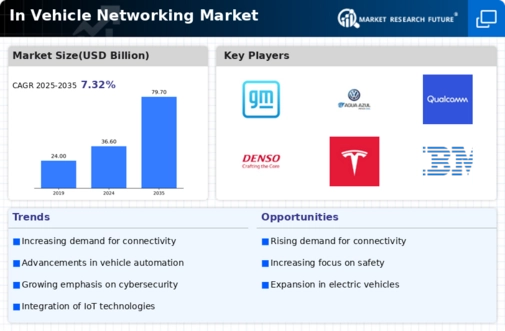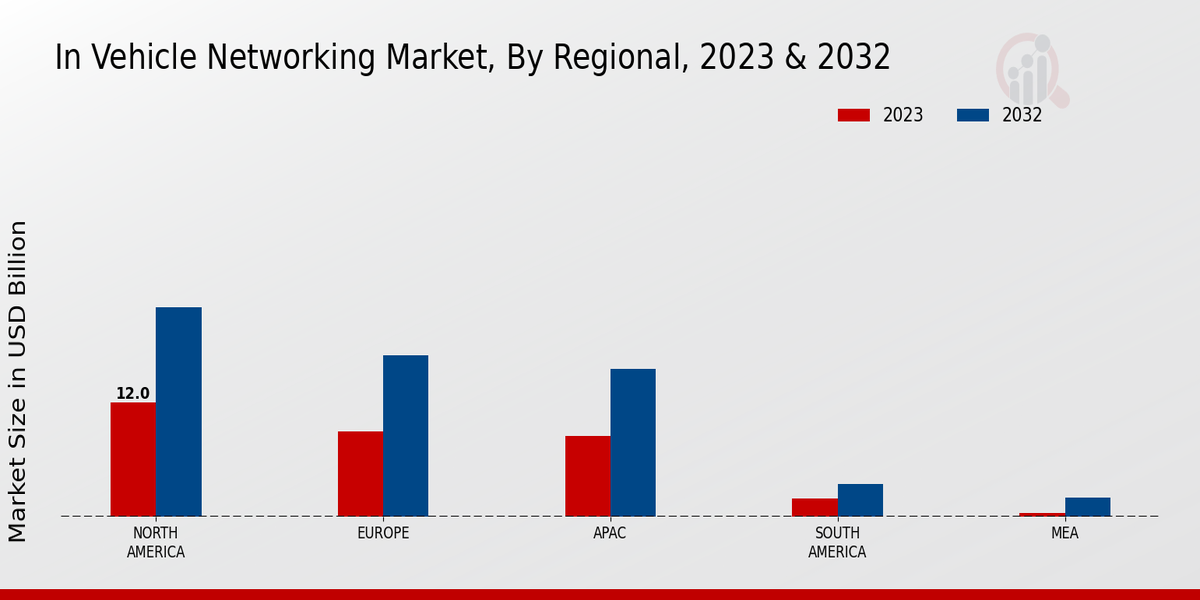Market Growth Projections
The Global In Vehicle Networking Market Industry is poised for substantial growth, with projections indicating a market value of 36.6 USD Billion in 2024 and an anticipated increase to 79.7 USD Billion by 2035. This growth trajectory suggests a compound annual growth rate (CAGR) of 7.32% from 2025 to 2035. Such figures underscore the increasing importance of in-vehicle networking solutions as the automotive industry evolves. Factors contributing to this growth include advancements in technology, rising consumer expectations, and the ongoing shift towards electric and autonomous vehicles. This market expansion reflects broader trends in connectivity and automation within the automotive sector.
Rise of Electric and Autonomous Vehicles
The Global In Vehicle Networking Market Industry is significantly influenced by the rise of electric and autonomous vehicles. As automakers pivot towards electrification and automation, the need for sophisticated in-vehicle networking solutions becomes paramount. These vehicles rely on seamless communication between various components to ensure optimal performance and safety. The anticipated growth in this sector is reflected in the market's projection to reach 79.7 USD Billion by 2035. This transition not only enhances vehicle efficiency but also aligns with global sustainability goals, further driving investments in advanced networking technologies.
Regulatory Compliance and Safety Standards
The Global In Vehicle Networking Market Industry is significantly shaped by stringent regulatory compliance and safety standards. Governments worldwide are implementing regulations that mandate advanced safety features in vehicles, which in turn drives the adoption of in-vehicle networking solutions. Compliance with these regulations necessitates the integration of sophisticated communication systems that can support various safety features. As a result, manufacturers are compelled to invest in advanced networking technologies to ensure compliance and enhance vehicle safety. This trend is expected to bolster market growth as the automotive industry adapts to evolving regulatory landscapes.
Increasing Connectivity and IoT Integration
The Global In Vehicle Networking Market Industry is witnessing an upsurge in connectivity and the integration of Internet of Things (IoT) technologies. As vehicles become more connected, the demand for reliable in-vehicle networks that facilitate communication between devices grows. This connectivity enables features such as real-time traffic updates, remote diagnostics, and over-the-air software updates. The market's compound annual growth rate (CAGR) of 7.32% from 2025 to 2035 indicates a robust growth trajectory, driven by consumer preferences for enhanced connectivity and convenience. Automakers are increasingly investing in these technologies to remain competitive in a rapidly evolving landscape.
Consumer Demand for Enhanced In-Car Experience
The Global In Vehicle Networking Market Industry is increasingly influenced by consumer demand for enhanced in-car experiences. Modern consumers expect their vehicles to offer advanced infotainment systems, seamless connectivity, and personalized features. This demand drives automakers to invest in sophisticated in-vehicle networking solutions that can support high-bandwidth applications and real-time data processing. As a result, the market is projected to grow significantly, reflecting the evolving preferences of consumers who prioritize technology and connectivity in their vehicles. This trend is likely to shape the future of automotive design and functionality.
Growing Demand for Advanced Driver Assistance Systems
The Global In Vehicle Networking Market Industry experiences a notable surge in demand for advanced driver assistance systems (ADAS). These systems enhance vehicle safety and improve overall driving experience, which is increasingly prioritized by consumers. As of 2024, the market is projected to reach 36.6 USD Billion, driven by innovations in sensor technology and connectivity solutions. The integration of ADAS features such as lane departure warnings and adaptive cruise control necessitates robust in-vehicle networks, thereby propelling market growth. This trend is expected to continue as manufacturers strive to meet regulatory safety standards and consumer expectations.













